Finding the best crib mattress for your infant can feel like a daunting quest through the marketing swamp. Companies bombard you with buzzwords, parenting forums have seemingly infinite posts, and new materials become popular every year. Thankfully, all modern crib mattresses are regulated by federal safety standards, but those guidelines still leave room for lots of variety.
I’ve assembled this guide to help clear up confusion and showcase the top crib mattresses being made today. Whether you’d like an updated innerspring model or an organic bed for your baby, you’re bound to find a good fit below.
What’s the Best Crib Mattress?
The Saatva Crib Mattress earned the top spot on this list because of its dual-sided innerspring design. Innerspring crib mattresses tend to be sturdy and long-lasting, and this one features a coil unit that strives to keep infants safely centered in the middle of the bed. Additionally, it’s made with certified eco-conscious materials such as organic cotton and natural latex.
Top 4 Crib Mattresses for 2024
- Saatva Crib Mattress – Editor’s Pick
- Brentwood Home EcoAir Waterproof Crib Mattress – Best Waterproof Crib Mattress
- Avocado Organic Crib Mattress – Best Organic Crib Mattress
- Naturepedic Classic Organic Cotton Crib Mattress – Best Affordable Crib Mattress
Compare the Best Crib Mattresses
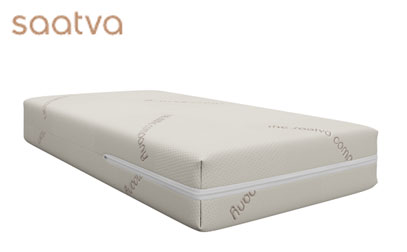
|
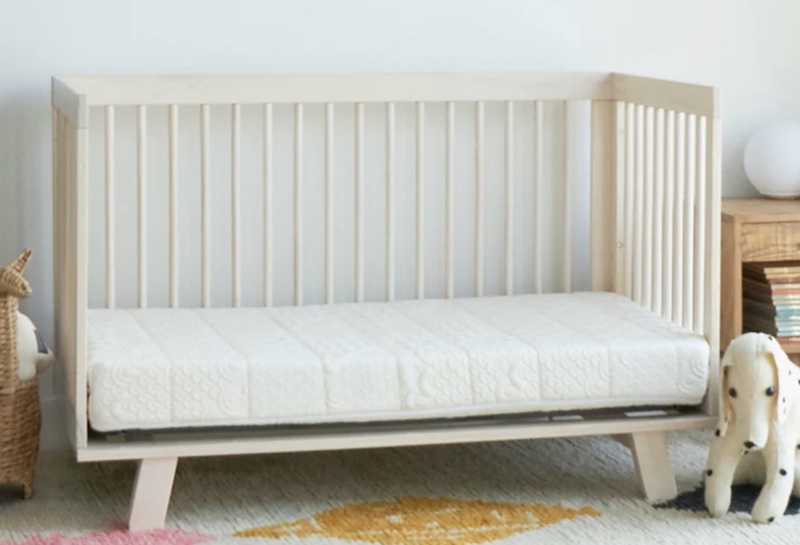
|
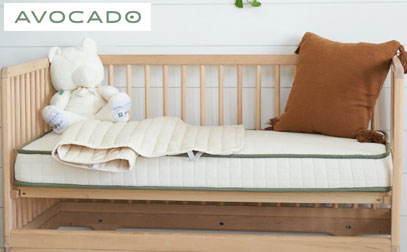
|
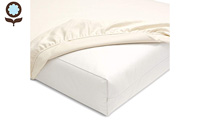
|
|
| Saatva Crib Mattress | EcoAir Waterproof Baby Crib Mattress | Avocado Organic Crib Mattress | Naturepedic Classic Organic Cotton Crib Mattress | |
| Rating | ||||
| Firmness | ||||
| Material | Hybrid | Other | Latex | Innerspring |
| Cooling | — | — | — | — |
| Warranty | Lifetime Warranty | 25 year warranty | Lifetime Warranty | |
| Shipping | Free shipping | Free shipping | Free shipping | |
| Trial Period | 45 Nights | 30 Nights | 100 Nights | |
| Best For | Kids | Kids | Kids | |
How Did We Pick the Best Crib Mattresses?
At Sleep Advisor, we typically review mattresses meant for adults by running them through a battery of tests in our studio. (Read our full product testing methodology to learn more.)
For crib mattresses, however, we had to change things up a bit. I looked at a combination of factors when evaluating these beds, including their overall construction, the presence or absence of certified organic materials, ease of cleaning, price, and customer reviews. I also sought advice from Nicole Johnson, a Pediatric Sleep Consultant.
At the end of the day, your baby’s safety and your peace of mind as a parent should be the major factors informing your choice of crib mattress.
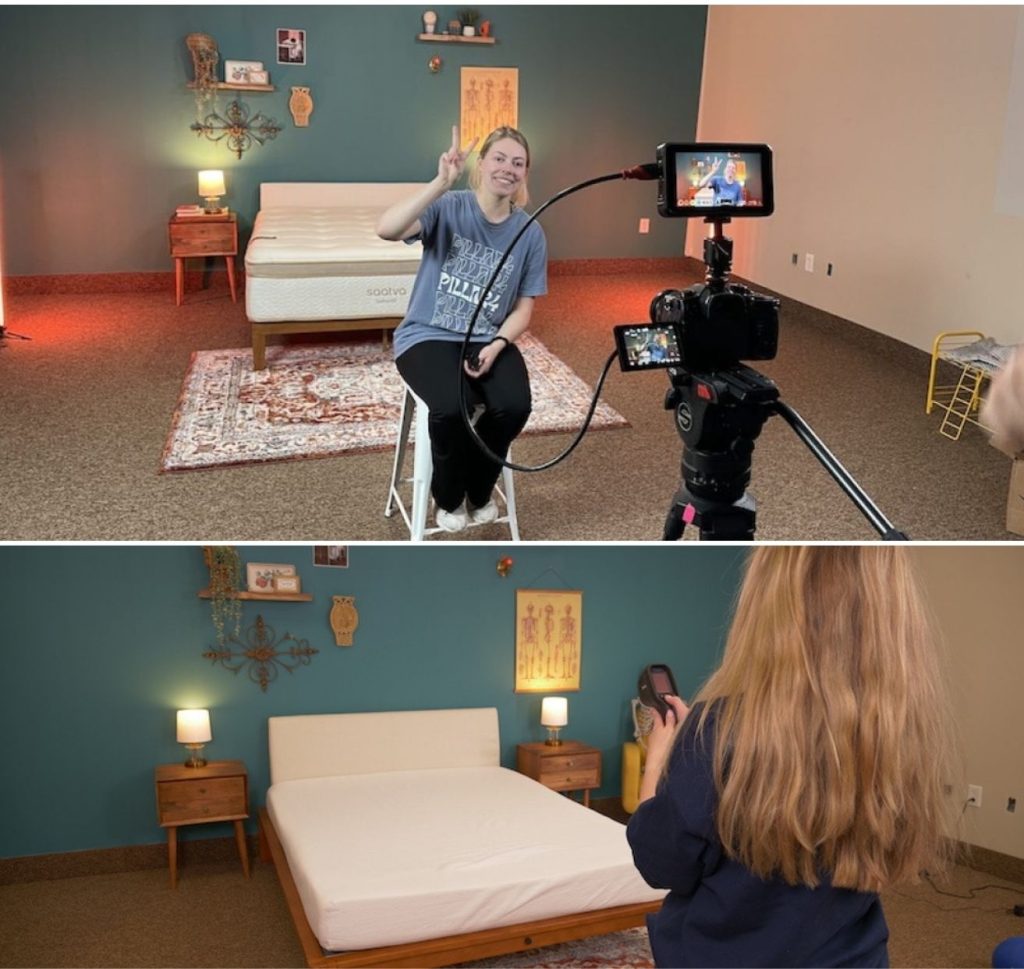
Advice from a Medical Expert
We reached out to Dr. Raj Dasgupta, who has over 20 years of experience in the medical field, to see his thoughts on what key qualities you should look for in a crib mattress.
“When picking out a crib mattress, focus on safety, firmness (it should be firm to support your baby’s spine), size (fits snugly in the crib with no big gaps), materials (non-toxic and hypoallergenic), waterproof cover, breathability (lets air flow through), durability, and look for certifications for peace of mind.”
What We Want to See in a Crib Mattress
Reliable Firmness
Perhaps counterintuitively, a baby’s crib mattress should not feel like the soft, inviting sleep surface you’d want for your own bedroom. Crib mattresses should be extremely firm and flat, and should not sag or retain any indentations at all after being pressed.
Certified Materials
Many crib mattresses advertise “green” and “eco-friendly” materials, but we like to privilege the brands that support these claims with trustworthy certifications. Organic textiles should carry a certification from the Global Organic Textile Standard (GOTS), for example.
Convenience
We chose crib mattresses that have at least one notable element of convenience. Maybe it’s especially lightweight and easy to move; maybe it cleans up without much hassle; maybe it has a flippable, dual-stage design that allows you to continue using it when your infant becomes a toddler.
Baby Crib Mattress Reviews – Best By Type
Saatva Crib Mattress – Editor’s Pick

Saatva Crib Mattress

Product Details
Our Recommendation
Why the Saatva Crib Mattress Earned Editor’s Pick
Saatva is a luxury brand, and its standards for excellence apply to their crib mattresses as well as their adult ones. This crib mattress is dual-sided, with one side intended for infants and the other for toddlers. Consequently, it can last for years—all up until your baby is ready for the big bed.
For me, the standout part of this crib mattress is its coils. Springs are some of the sturdiest support materials you can find in a baby’s bed, and these come with multiple special touches.
Firstly, they’re made of recycled steel, a reflection of Saatva’s commitment to eco-friendly materials. Secondly, they’re reinforced along the edges so the sides of the mattress are extra strong. And lastly, they feature what Saatva calls “center-zone technology,” which strives to keep your baby ideally positioned in the center of the crib.
This advanced innerspring unit, as well as the crib mattress’s emphasis on natural over synthetic components, earned it the title of Editor’s Pick.
What’s the Saatva Crib Mattress Made Of?
The Saatva Crib mattress is a dual-sided model meant to last your child from infancy through toddlerhood. The firmer side is for babies, while the softer one is for toddlers. We’ll describe the layers with the “baby side” up.
- Dimensions: 28” x 52”
- Layer 1 – Organic Cotton Cover. A cover made of breathable organic cotton. It’s removable and washable, as well as protected by a water-repellent treatment.
- Layer 2 – Transitional Support Layer. An especially firm layer meant to evenly support an infant, woven with eucalyptus fibers.
- Layer 3 – Center Coil Unit. Recycled steel springs further reinforce the support of the crib mattress. “Center-zone technology” aims to keep your baby squarely in the middle of the crib, and built-in edge support strengthens the sides.
- Layer 4 – Transitional Support Layer. Another firm support layer with eucalyptus fibers.
- Layer 5 – Natural Latex Layer. A springy, hypoallergenic layer that should provide a bit of pressure relief to growing toddlers when the mattress is flipped.
- Layer 6 – Organic Wool. GOTS-certified organic New Zealand wool tops the toddler side of the crib mattress. It’s breathable and moisture-wicking as well as resistant to microbes and dust mites.
Our Take: Although this mattress is pretty costly, you’re essentially getting two beds in one. Saatva’s advanced innerspring technology and devotion to safe, chemical-free materials elevate this crib mattress above much of the competition.
What We Liked
- Safety certifications – Due to its reliance on eco-friendly and natural materials over synthetic ones, this mattress also holds an impressive number of certifications. It’s UL GREENGUARD Gold Certified, so you don’t have to worry about potentially harmful emissions. Its latex layer is also Cradle to Cradle GOLD Certified™, meaning it meets high standards for sustainable manufacturing processes and resource management.
- Washable cover – The Saatva crib mattress has an organic cotton cover that’s also removable and washable. It sports a water-repellent treatment that makes it easy to clean if accidents happen.
Potential Drawbacks
- High price – Although not everyone has the same budget, some people may find this crib mattress’s price tag—around $350—to be too expensive.
- Shorter return period – Saatva offers a 45-day window for free returns of this crib mattress. That’s certainly a better return policy than none at all, but it’s a rather short period of time considering the mattress’s cost.
Brentwood Home EcoAir Waterproof Crib Mattress – Best Waterproof Crib Mattress

EcoAir Waterproof Baby Crib Mattress

Product Details
Our Recommendation
Financing Options
Financing options are available for this mattress.
Why the Brentwood Home EcoAir Waterproof Crib Mattress Earned Best Waterproof Crib Mattress
This dual-sided crib mattress by Brentwood Home is ready to withstand almost any mess. At the top of the toddler side, a waterproof polyurethane coating allows caretakers to quickly wipe up accidents. The entire cover is also removable and washable.
But an even deeper clean is both possible and easy: the core of the bed is made from PETE (Polyethylene Terephthalate) with an open, airy structure, enabling you to remove and rinse or spray it as needed.
What’s the Brentwood Home EcoAir Waterproof Crib Mattress Made Of?
This crib mattress has two sides: a firmer side for infants and a slightly less firm one for toddlers. We’ll describe the construction with the baby side up.
- Dimensions: 28″ x 52″
- Layer 1 – Organic Cotton. This breathable cover is certified by the Global Organic Textile Standard (GOTS).
- Layer 2 – REPREVE® Recycled Polyester and Naturally Hydrated Silica. Brentwood Home says that this layer incorporates 14 repurposed water bottles in addition to REPREVE® stuffing yarn. Also within these cover panels is natural hydrated silica, which acts as a fire retardant.
- Layer 3 – Organic Cotton Jersey. This fabric is likewise GOTS-certified.
- Layer 4 – Firm PETE Core. Brentwood Home claims that this core is 90% air, which helps to regulate its temperature.
- Layer 5 – Medium-Firm PETE Core.
- Layer 6 – Inner Waterproof Liner. Ideal for toddlers in the midst of potty training, this waterproof layer is made from polyurethane film and a polyester blend.
- Layer 7 – REPREVE® Recycled Polyester.
- Layer 8 – Organic Cotton.
Our Take: Convenience is the key word when it comes to describing this crib mattress. Most of its components are easy to clean, and the bed itself weighs less than 20 pounds so parents can flip and maneuver it without much trouble.
What We Liked
- Washable design – The covers on both sides of this crib mattress are machine-washable, and the EcoAir core can be cleaned by hand with cool water and mild detergent. According to the brand, you could even bring the core into the shower with you.
- Recycled and recyclable materials – Recycled polyester and repurposed water bottles add to this mattress’s eco-friendly credentials. Even its zipper is made from recycled REPREVE® material! Additionally, its core is recyclable, so it shouldn’t end up in a landfill after your child switches to a larger bed.
Potential Drawbacks
- It contains polyester and polyurethane – Although this bed has multiple certifications to indicate its safety and eco-friendliness, some shoppers may prefer more natural materials.
- Claims about the core’s breathability shouldn’t be tested – Brentwood Home says that this mattress’s core “reduces suffocation risk,” but an infant should never have to breathe “through” a mattress—this claim is largely a marketing tactic and not a verified feature. Always place your baby on their back when putting them to bed.
Avocado Organic Crib Mattress – Best Organic Crib Mattress

Avocado Organic Crib Mattress

Product Details
Our Recommendation
Why the Avocado Organic Crib Mattress Earned Best Organic Crib Mattress
Avocado takes its organic materials incredibly seriously. Not only does the brand avoid synthetics and chemicals in the construction of its mattresses, it’s also directly involved in the farming and manufacturing of those materials.
Its organic, dual-sided crib mattress contains certified organic latex, organic wool, and organic cotton. All of these ingredients come from India, where Avocado co-owns both farmer’s societies and a processing facility. What’s more, the core of the mattress is made of coconut husk fiber rather than foam or springs.
What’s the Avocado Organic Crib Mattress Made Of?
This crib mattress is dual-sided and flippable. The firmer side is intended for babies up to one year old, whereas the less-firm side is for toddlers between one and four years old. We’ll describe the construction with the infant side at the top.
- Dimensions: 28” x 52”
- Layer 1 – Organic Cotton Cover. GOTS-certified organic cotton can be found on both sides of the crib mattress.
- Layer 2 – Organic Wool. Wool acts as a natural fire-resistant component of this bed. It can also help with temperature regulation and moisture-wicking.
- Layer 3 – Coconut Husk Fiber Infused with Organic Latex. The core of the crib mattress combines natural coconut husk fibers and GOLS-certified organic latex for a suitably firm support layer.
- Layer 4 – Toddler Support Layer(s). For toddlers, the crib mattress features a slightly more plush feel, made up of a layer of organic latex and a 0.5-inch layer of coconut husk.
- Layer 5 – Organic Wool.
- Layer 6 – Organic Cotton Cover.
Our Take: Out of all the crib mattresses on this list, this one has the most third-party certifications and awards attesting to the sustainability quality of its natural materials. It’s quite pricey, but it’s the one to buy if you’re dedicated to shopping green.
What We Liked
- Coconut husk core – Using coconut husk as a natural support material is catching on in the crib mattress world for good reason. These fibers are tough enough to lend a mattress the firmness an infant needs, all without any synthetic foams or metal springs.
- Handmade – Avocado handmakes its mattresses (for adults and children) in Los Angeles at its factory. Even the factory itself is GOTS-certified, ensuring that the textiles meet the high standards of the organic label and that the workers who handle them are treated fairly.
Potential Drawbacks
- The luxury price – Because of all the quality control that goes into its construction, this is the costliest crib mattress in this roundup, priced at a little under $450.
- No built-in waterproofing – Avocado’s crib mattress doesn’t have a waterproof or water-resistant layer. The brand recommends buying a few of its GOTS-certified organic cotton protector pads (or a waterproof cover from another company) to shield it from messes.
Naturepedic Classic Organic Cotton Crib Mattress – Best Affordable Crib Mattress

Naturepedic Classic Organic Cotton Crib Mattress

Product Details
Our Recommendation
Why the Naturepedic Classic Organic Cotton Crib Mattress Earned Best Affordable Crib Mattress
Even though it boasts organic materials and its own bevy of certifications, the Naturepedic Classic Organic Cotton Crib Mattress is the most affordable crib mattress on our list. It’s also available in three variants: a one-sided version that’s solely for infants ($269), a two-sided lightweight version with a polyethylene core ($299), and a two-sided innerspring version ($329).
We were especially charmed by the fact that this crib mattress’s waterproof layer is food-grade and made from LDPE (low-density polyethylene) derived from sugarcane.
What’s the Naturepedic Classic Organic Cotton Crib Mattress Made Of?
We’ll outline the layers of the most budget-friendly version of this mattress, the single-sided lightweight model.
- Dimensions: 27 1/4″ x 51 5/8″
- Layer 1 – Waterproof Cover. The cover of this crib mattress is organic cotton coated with waterproof LDPE fibers made from sugarcane.
- Layer 2 – Firmness Support Layer. A polypropylene support layer helps create bracing firmness.
- Layer 3 – Organic Cotton Batting. Organic cotton grown in America fills out the third layer of the crib mattress.
- Layer 4 – WaveSupport™ Core. Also made of LDPE, this core doesn’t weigh as much as innersprings while still providing reliable firmness.
Our Take: We appreciate the multiple construction options available for this crib mattress, as well as its waterproof cover and the easy-to-maneuver lightness of the non-innerspring versions. It’s a well-made bed that’s a tad more budget-friendly than our other selections.
What We Liked
- Long trial and warranty – Naturepedic gives you 100 nights to test out this crib mattress, and there’s a generous lifetime warranty on it.
- Waterproof seams – Even the seams at the edges of this crib mattress have been waterproofed as well as heat-sealed. This thorough treatment should prevent any liquids from getting inside the mattress’s structure.
Potential Drawbacks
- The innerspring version is heavy – The Naturepedic Crib mattress with coils is heavier than the lightweight versions, which don’t contain coils. The extra weight may be a drawback if you change the sheets or clean the mattress often.
- The cheapest version is not dual-sided – If you’re looking for a flippable two-stage crib mattress that will accommodate a toddler in later years, you’ll have to pay a bit more for one of the dual-sided versions of this bed.
How to Choose the Best Crib Mattress for Your Baby: Key Considerations
A variety of crib mattresses will try to catch your eye with marketing tactics, but you’ll naturally want to prioritize your baby’s safety and comfort over everything else.
Thankfully, full-size crib mattresses made today are subject to federal regulations via the U.S. Consumer Product Safety Commission (CPSC), so they should already meet several important safety standards.
These rules ensure that crib mattresses undergo thorough testing and quality assurance measures before they can be sold. They cover aspects including size, firmness, labeling, and the presence of potentially harmful substances such as lead and phthalates.1
Beyond these legal requirements, though, you’ll want to conduct your own research to make an informed decision. Here are the key considerations to keep in mind while shopping for a baby’s crib mattress.
Firmness
According to the American Academy of Pediatrics, crib mattresses should be firm and flat (not inclined). The organization defines a firm surface as one that “maintains its shape and does not indent or conform to the shape of the infant’s head when the infant is placed on the surface.” If a baby’s mattress is too soft, it can increase the risk of suffocation.2
All crib mattresses must pass initial firmness tests set by the CPSC, but that still leaves room for some variation in their feel. In fact, a 2021 study found that some infant mattresses on the market were just as soft as certain beds meant for adults3—and that’s definitely not what you want.
Look for a crib mattress that won’t depress much at all under your hand, and that immediately bounces back to its full shape. If the crib mattress feels soft or squishy, it’s likely unsafe for a baby.
Size and Crib Fit
According to the CPSC, a full-size crib mattress must be within ⅝ inches of 52⅜ inches long and within ⅝ inches of 28 inches wide, as well as 6 inches thick.4
More important than the mattress’s precise dimensions, though, is how well it fits inside your baby’s crib. The mattress should lay flat and snug inside the crib, with a gap no larger than the width of two fingers between the mattress edge and the side of the crib.5
A gap wider than this could cause dangerous wedging, which occurs when an infant’s body or limb is caught between the mattress and the structure of the crib.
Materials
When it comes to the materials inside your infant’s crib mattress, you’ll have a fair number of choices. This is one facet of shopping for a crib mattress that can seem like a neverending rabbit hole. However, you can typically group crib mattresses into four categories based on their construction:
Innerspring Crib Mattresses
These crib mattresses have metal springs as their support system, making them especially durable. They also have an initial comfort layer or two so your baby doesn’t feel any poking from the coils.
Because they last so long, crib mattresses with springs tend to cost more than other types. They also tend to be heavier and a little more difficult to move. But, you’ll be hard-pressed to find a sturdier, more reliable bed for a baby.
Foam Crib Mattresses
Foam crib mattresses are primarily made of polyurethane foam. The foam should be very firm—not contouring, like the memory foam used in adult beds.
This kind of crib mattress will be easier to lift than an innerspring model, and they’re priced more cheaply, too. But they’re also liable to wear out and need replacing sooner.
Organic and “Natural” Crib Mattresses
If you like to shop green or chemical-free, you may be enticed by one of the many crib mattresses with organic or natural components. These can include organic cotton, natural latex foam, wool, and even coconut fibers.
Although a lot of companies say that their crib mattresses are eco-friendly, natural, or “green,” some of them lack trustworthy third-party certifications to back these claims. If you’re looking for a crib mattress with little to no artificial materials inside it, you’ll want to familiarize yourself with the various mattress certifications and what they mean.
In particular, crib mattresses with certifications from the Global Organic Textile Standard (GOTS), Global Organic Latex Standard (GOLS), and UL GREENGUARD are likely to have quality materials in this vein.
Air Core and “Breathable” Crib Mattresses
A fairly recent innovation, crib mattresses with cores made of “mostly air” are becoming popular. The cores consist of a webbing of synthetic polymers that can hold strong while allowing lots of air to pass through. These cores may even be washable.
Air-core crib mattresses market themselves as highly breathable, which can be helpful for temperature regulation. But don’t take taglines that say a baby can “breathe through” a given crib mattress literally—a baby should never need to breathe through a mattress, as they should always sleep on their backs.
One- or Dual-Sided
Some crib mattresses are flippable, with one side intended for newborns and young infants, and the other intended for toddlers. The toddler side is usually just a little bit softer (but it should still be quite firm, and will have met the CPSC standards for crib mattress firmness).
A dual-sided crib mattress can be convenient and last you for years, but it may also be more expensive and less specialized overall than a crib mattress dedicated solely to infants. There’s no wrong choice here, as long as the mattress meets your baby’s needs.
Waterproofing and Cleaning
Babies are messy, even when they’re sleeping, so you’ll want to know how your crib mattress and its cover can best be cleaned. Pay attention to the manufacturer’s instructions for cleaning or washing the outer parts of the mattress, and prioritize ones that seem easy and convenient to wipe down.
“A washable cover is so helpful if you have a baby who leaks diapers or spits up a lot while sleeping,” said Nicole Johnson, the lead Pediatric Sleep Consultant for and founder of The Baby Sleep Site®. “I also tell parents to consider adding multiple layers of waterproof crib sheets for quick middle-of-the-night changes. Leave the laundry to the morning!”
Some crib mattresses come with a waterproof or water-resistant cover, whereas others may require you to purchase a cover separately. Here, too, you’ll want to be mindful of materials: some parents prefer to avoid vinyl covers because of the potential presence of phthalates.
Phthalates and Crib Mattress Covers
One 2015 study, which found phthalates (or other types of plasticizers) in the majority of the crib mattress covers examined, notes that these substances could potentially impact reproductive development in males, as well as susceptibility to allergies and asthma.6
If you want a phthalate-free waterproof cover for your child’s crib mattress, look for covers that don’t contain vinyl or PVC (polyvinyl chloride).
Weight
When you’re changing the fitted sheet on your infant’s crib mattress, or cleaning the mattress itself, you’ll have to lift and move it. A very heavy crib mattress will be more difficult to maneuver than a lightweight one.
Price
You may not have the budget for an extremely state-of-the-art crib mattress, but you don’t want to be so thrifty that you neglect safety considerations, either.
You should set aside close to $100 so you can afford a new crib mattress that’s held to the latest set of federal regulations. From there, you can determine how much you’re willing to spend on a crib mattress with premium materials or other standout features.
How to Set Up Your Crib Mattress Safely
- Check the crib mattress for firmness and fit. Remember that crib mattresses should feel very firm, and fit snugly inside the crib. The gap between the edge of the mattress and the wall of the crib should not exceed the width of two fingers.
- Check the crib mattress for damage or loose components. The crib mattress should not have obviously dangling threads, rips, or any other defects.
- Keep the crib empty. Do not place stuffed toys, blankets, or pillows inside the crib with your infant.
- Always put your baby to bed on their back. Babies should not sleep on their stomachs or sides—these positions have been proven to increase the risk of SIDS.7
- Lower the crib mattress when appropriate. As your baby gets bigger, they’ll need a crib mattress setup that accommodates their height and range of movement while preventing them from climbing or falling out of the crib. According to the National Library of Medicine, you should lower the crib mattress as your child learns to roll and sit up, and again just before they learn to stand.8
Baby Mattress FAQs
What type of crib mattress is best for a baby?
To decide which kind of crib mattress to buy, you’ll have to weigh your priorities against the advantages of each type. Innerspring crib mattresses are very durable and strong; foam crib mattresses are the most affordable and lightweight; organic crib mattresses boast chemical-free materials.
No type is inherently better than the other, as long as your baby’s crib mattress abides by the CPSC’s standards and is firm, flat, and level (not tilted or on an incline).
How can you tell if a crib mattress is made of safe materials?
Look for certifications from reputable third-party organizations that test for certain harmful substances and emissions, such as CertiPUR-US®, OEKO-TEX®, and UL GREENGUARD. Opt for an organic mattress if natural materials are very important to you. If a company is cagey or vague about what its crib mattresses contain, steer clear.
What are the best dimensions for a crib mattress?
The Consumer Product Safety Commission (CPSC) mandates that full-size crib mattresses be at least 51⅝ inches (1310 millimeters) long and 27¼ inches (690 millimeters) wide.
These are minimum measurements. To get even more specific, they define the dimensions of a full-size crib as within ⅝ inches of 52⅜ inches (between 1314 and 1346 millimeters) long and within ⅝ inches of 28 inches (between 695 and 727 millimeters) wide.
How thick should a mattress be for a newborn?
A crib mattress should be 6 inches thick at most, per CPSC guidelines.
What is the best organic crib mattress?
The Avocado Organic Crib Mattress is the top organic crib mattress that we recommend. That said, there are a variety of organic crib mattresses on the market, and the one that works best for you will depend on your preferences regarding budget, materials, and ease of cleaning.
Just make sure that the bed’s organic claims are backed up by trustworthy organizations. Look for certifications from the Global Organic Textile Standard (GOTS) and Global Organic Latex Standard (GOLS) in particular.
How much should you spend on a crib mattress?
Anticipate spending around $100 for a budget crib mattress, and around $300 or more for specialty and organic versions. Never buy a secondhand or outdated crib mattress to save money—older crib mattresses were not held to the safety standards of today.
What is the life expectancy of a crib mattress?
A crib mattress should last you a few years, around five at the most. Always replace the mattress if you notice obvious signs of wear or damage.
Can you reuse a crib mattress?
You may be able to reuse a crib mattress if it’s undamaged, clean, and has retained its original firmness level, but generally, we recommend buying a new crib mattress for each baby. Newer crib mattresses are often held to more rigorous safety standards than older ones.
We also don’t recommend using a secondhand crib mattress from another home, as you can’t be sure of its history.
Are crib and toddler mattresses the same size?
Yes, a standard toddler mattress is the same size as a crib mattress, which is why many crib mattresses have a dual-sided construction (one side for infants, one side for toddlers). A toddler mattress typically has a somewhat softer feel than a crib mattress, but should still feel very firm compared to an adult’s bed.
When your toddler grows even more, it’ll be time to take a look at some of the best mattresses for kids.
When should you lower your baby’s crib mattress?
The National Library of Medicine recommends lowering your baby’s crib mattress just before they learn to sit up, and lowering it again (so it’s at its lowest) when they’re on the brink of standing.8 The timeline for these milestones will vary from baby to baby—you’ll want to anticipate them for your child and lower the crib mattress shortly before they happen.
When should you flip a crib mattress?
If your crib mattress has a dual-sided design, you can likely flip it when your child has reached certain milestones that signal toddlerhood, such as full head control, easy movement and climbing, and the ability to roll over in both directions (from their back to their stomach, and back again).
This transition may happen around 12 months or later—every child is different. Only flip a crib mattress if it has a designated toddler side, and always check with your pediatrician first. Note that the National Institute of Health recommends that babies be put on their backs to sleep until they are one year old.9
Recap: The Best Crib Mattresses
| Mattress | Best For | Price |
| Saatva Crib Mattress | Editor’s Pick | $355 |
| Brentwood Home EcoAir Waterproof Crib Mattress | Waterproof | $349 |
| Avocado Organic Crib Mattress | Organic | $439 |
| Naturepedic Classic Organic Cotton Crib Mattress | Affordable | $269 |

Julia Forbes
Lead Product Tester
About Author
Julia is the Lead Reviewer at Sleep Advisor, specializing in testing out mattresses and sleep accessories – she’s in the right line of work, because she loves to sleep.
Stomach Sleeper
Education & Credentials
- Certified Sleep Science Coach
References:
- “Crib Mattresses Business Guidance and Small Entity Compliance Guide”. United States Consumer Product Safety Commission. Webpage accessed February 9, 2024.
- Moon, Rachel Y., Carlin, Rebecca F., & Hand, Ivan. “Evidence Base for 2022 Updated Recommendations for a Safe Infant Sleeping Environment to Reduce the Risk of Sleep-Related Infant Deaths”. American Academy of Pediatrics. July 2022.
- Gillani, Sheena H., Lowell, Gina S., & Quinlan, Kyran P. “A firm recommendation: measuring the softness of infant sleep surfaces”. Injury Epidemiology. September 13, 2021.
- “Safety Standard for Crib Mattresses”. Federal Register. February 15, 2022.
- “Crib Safety”. University of Pittsburgh Medical Center. Webpage accessed February 9, 2024.
- Boor, Brandon E. et al. “Identification of Phthalate and Alternative Plasticizers, Flame Retardants, and Unreacted Isocyanates in Infant Crib Mattress Covers and Foam”. Environmental Science & Technology Letters. March 2, 2015.
- “Ways to Reduce Baby’s Risk”. National Institute of Child Health and Human Development. Webpage accessed February 9, 2024.
- “Cribs and crib safety”. MedlinePlus, National Library of Medicine. Webpage accessed February 9, 2024.
- “About Back Sleeping”. National Institute of Child Health and Human Development. Webpage accessed February 9, 2024.
